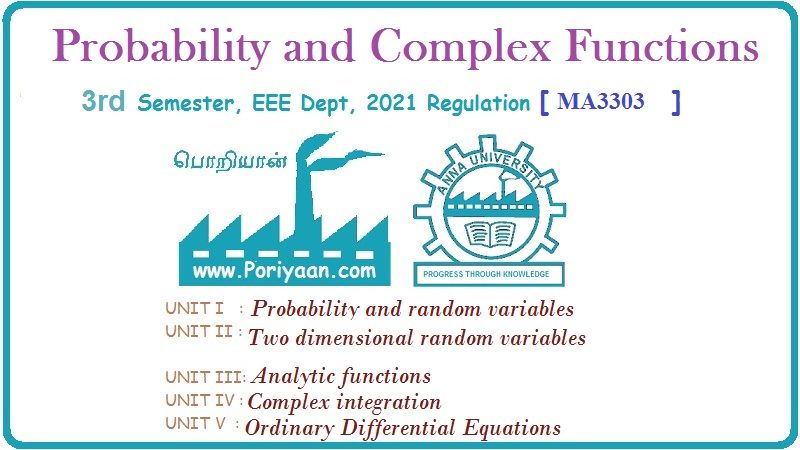Probability and complex function: Unit III: Analytic functions
Bilinear transformation
Theorem, Proof, Definition | Analytic functions
The transformation w = az + b/ cz + d’ – bc ≠ 0 where a, b, c, d are complex numbers, is called a bilinear transformation.
BILINEAR
TRANSFORMATION
Introduction :
The
transformation w = az + b/ cz + d’ – bc ≠ 0 where a, b, c, d are complex numbers,
is called a bilinear transformation.
This
transformation was first introduced by A.F. Mobius. So it is also called Mobius
transformation.
A
bilinear transformation is also called a linear
fractional transformation because az + b / cz + d is a fraction formed by
the linear functions az + b and cz + d.
Theorem
3.5.1.
Under
a bilinear transformation no two points in z plane go to the same point in w
plane.
Proof :
Suppose
z1 and z2 go to the same point in the w plane under the transformation
w = az + b/ cz + d'
az1
+ b/cz1 + d = az2 + b / cz2 + d
i.e.,(az1
+ b) (cz2 + d) - (az2 +b) (cz1 + d) = 0
acz1z2
+ adz1 + bcz2+ bd - acz1z2 -
adz2 - bcz1 - bd = 0
(ad - bc) (z1 - z2) = 0
or
z1 = z2 [ ad - bc
#0]
This
implies that no two distinct points in the z plane go to the same point in the
w plane. So, each point in the z plane goes to a unique point in the w plane.
Definition 3.5. (a)
Fixed points (or) Invariant points (OR) Prove that a bilinear transformation
has atmost two fixed points. [A.U. M/J 2012]
The
fixed points of the transformation
w
= az + b/cz + d is obtained from
z
= az + b/cz + d (or) cz2 + (d - a) z - b = 0
These
points are two in number unless the discriminant is zero in which case the
number of points is one.
Remark:
Though a bilinear transformation involves a, b, c, d effectively it involves
only three constants because az + b and cz + d can be divided by one of a, b,
c, d which is non zero so that one of them is 1.
This
shows that there is just one bilinear transformation that maps three given
distinct points z1, z2, z3 into three
specified points w1, w2, w3.
If
a ≠ 0 and c ≠ 0, then the transformation can be assumed to be w = A z + B/z +
C (where A = a/c, B = b/a, C = d/c)
otherwise, it can not be done so.
Theorem 3.5.2. The
bilinear transformation which transforms z1, z2,z3
into W1, W2, W3 is (w – w1) (w2
– w3)/ (w – w3) (w2 – w1) = (z – z1)
(z2 – z3)/ (z – z3) (z2 – z1)
Proof: If
the required transformation is w = az + b/cz + d

=
az + b/cz + d , Here a = Aw1 –
Bw3 b = Bw3z1 – Aw1z3 c
= A – B , d = B z1 – Az3
Definition : 3.5.(b)
Cross ratio
Given
four points z1, z2, z3, z4 in this
order, the ratio (z1 – z2) (z3 – z4)
/(z2 – z3) (z4 – z1) is called the
cross ratio of the points.
Note (1):
w = az + b / cz + d can be expressed as cwz + dw - (az + b) = 0
It
is linear both in w and z that is why, it is called bilinear.
Note (2):
This transformation is conformal only when dw/dz # 0
i.e.,
ad – bc /(cz+d)2 ≠ 0
i.e.,
ad – bc ≠ 0
If
ad - bc = 0, every point in the z plane is a critical point.
Note (3) : Now,
the inverse of the transformation w = az + b/cz + d z = -dw + b / cw – a which
is also a bilinear transformation except w = a/c.
Note (4)
Each point in the plane except z = -d/c corresponds to a unique point in the
w-plane.
The
point z = -d/c corresponds to the point at infinity in the w plane.
Note (5):
The cross ratio of four points
(w1
- w2) (w3 - w4)/ (w2 – w3)
(w4 – w1) = (z1
- z2) (z3 - z4)/ (z2 – z3)
(z4 – z1) is invariant under bilinear transformation.
Note (6) : If
one of the points is the point at infinity the quotient of those difference
which involve this point is replaced by 1.
Suppose
z1 = ∞, then we replace z – z1 / z2 –
z1 by 1 (or ) Omit the factors involving ∞
Probability and complex function: Unit III: Analytic functions : Tag: : Theorem, Proof, Definition | Analytic functions - Bilinear transformation
Related Topics
Related Subjects
Probability and complex function
MA3303 3rd Semester EEE Dept | 2021 Regulation | 3rd Semester EEE Dept 2021 Regulation
